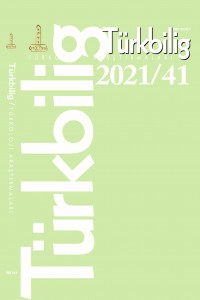Öz
Türk runik harfli eski Türk yazıtlarında, savaşlar, diplomatik ilişkiler gibi askerî ve yönetim ile ilgili konular epeyce yer tutuyor olsa da gündelik hayata dair izler de yer almaktadır. Çok zaman açık olarak ifade edilmemiş gibi görünse de bu izleri cümleler arasından seçebilmek mümkündür. Bitkiler, hayvanlar, zamanın ifade edilişi ve bazı inanç öğeleri, gündelik hayata dair en önemli bulgular olarak değerlendirilmektedir. Bu da eski Türk yazıtları marifetiyle eski dönem Türkler hakkında daha fazla bilgi edinilmesine imkân vermektedir.
Eski Türk yazıtlarında tespit edilen hayvanlar da gündelik hayatın önemli bir parçası olarak değerlendirilmelidir. Bu hayvan adlarının bir bölümü doğrudan hayvan adı ile, bir bölümü yer adlarında geçmiş olması dolayısıyla bir bölümü ise on iki hayvanlı takvimde bir yılı göstermesinden dolayı elde edilmiştir.
Bu makalede, Türklerin yaşadığı İç ve Orta Asya ile Sibirya’nın güney bölümlerinde yaşamıyor olmasından dolayı hayvan adı olarak tespit edilmemiş olan ve eski Türk yazıtlarında toplam dört kez tespit edilen ‘maymun’ anlamındaki bėçin sözcüğünün kökeni ile ilgili yeni bir öneri dikkatlere sunulacaktır. Makalede, önce eski Türk yazıtlarındaki görünüşü, yazımı, Türkçenin öteki dönemlerindeki tanıkları gibi konular üzerinde durulduktan sonra sözcüğün kökeni ile ilgili görüşlere değinilecektir. Ardından yeni bir öneri olarak Çince bingshen (丙申) birleşiği dikkatlere sunulacak ve birleşiğin eski Türkçe metinlerde bėçin biçimini aldığı vurgulanacaktır. Bingshen (丙申) birleşiğinin özellikle orta Çince metinlerdeki kullanım alanı ile takvim ve dolayısıyla zaman ifadesi konularında da bilgi verilecektir.
Anahtar Kelimeler
Kaynakça
- Ata, Aysu (1998). Nehcü’l-Ferādis III, Dizin-Sözlük. Ankara: Türk Dil Kurumu.
- Aydın, Erhan (2008). Şine Usu Yazıtında Hayvan Adlarıyla Kurulmuş Yer Adları Üzerine İncelemeler. Turkish Studies, International Periodical For the Languages, Literature and History of Turkish or Turkic, 3/1, 202-208.
- Aydın, Erhan (2011). Eski Türk Yazıtlarındaki Çıntan Igaç ‘Sandal ağacı’ Üzerine. Bilig, 56, 25-32.
- Aydın, Erhan (2014). Kök Haya (Hakasya) Yazıtı Üzerinde Yeni Okuma ve Anlamlandırmalar. Gazi Türkiyat, 14, 41-46.
Öz
Although military and administrative issues such as wars and diplomatic relations occupy a large place in the old Turkic inscriptions with Turkic runic letters, there are also traces of daily life. Although it does not seem to be clearly expressed most of the time, it is possible to pick out these traces from among sentences. Plants, animals, the expression of time and some elements related to belief are considered as the most important findings about daily life. This allows to obtain more information about the ancient Turks by means of the old Turkic inscriptions.
The animals identified in the old Turkic inscriptions should also be considered as an important part of daily life. Some of these animal names were derived directly from the name of the animal, some of them in the place names, and some due to the fact that it indicates a year in the calendar with twelve animals.
In this article, a new proposal will be presented regarding the origin of the word bėçin which means ‘monkey’ and which has not been identified as an animal name due to the fact that this animal does not live Central and Inner Asia and in the southern parts of Siberia which the areas that Turks live, however this animal name has been identified four times in the old Turkic inscriptions. In the article, after focusing on issues such as its appearance in the old Turkic inscriptions, its writing, and the witnesses of this name in other periods of Turkic, the views on the origin of the word will be discussed. Then, as a new suggestion, the Chinese bingshen (丙申) compound will be brought to attention and it will be emphasized that the compound takes the form of bėçin in old Turkic texts. Information will also be given about the usage area of the Bingshen (丙申) compound, especially in the middle Chinese texts, and on the calendar and therefore the expression of time.
Anahtar Kelimeler
Old Turkic Old Turkic Inscriptions Animal Names Calendar with Twelve Animals Bėçin Monkey.
Kaynakça
- Ata, Aysu (1998). Nehcü’l-Ferādis III, Dizin-Sözlük. Ankara: Türk Dil Kurumu.
- Aydın, Erhan (2008). Şine Usu Yazıtında Hayvan Adlarıyla Kurulmuş Yer Adları Üzerine İncelemeler. Turkish Studies, International Periodical For the Languages, Literature and History of Turkish or Turkic, 3/1, 202-208.
- Aydın, Erhan (2011). Eski Türk Yazıtlarındaki Çıntan Igaç ‘Sandal ağacı’ Üzerine. Bilig, 56, 25-32.
- Aydın, Erhan (2014). Kök Haya (Hakasya) Yazıtı Üzerinde Yeni Okuma ve Anlamlandırmalar. Gazi Türkiyat, 14, 41-46.
Ayrıntılar
| Birincil Dil | Türkçe |
|---|---|
| Konular | Dil Çalışmaları |
| Bölüm | Araştırma Makaleleri |
| Yazarlar | |
| Yayımlanma Tarihi | 29 Haziran 2021 |
| Gönderilme Tarihi | 19 Ocak 2021 |
| Yayımlandığı Sayı | Yıl 2021 Cilt: 2021 Sayı: 41 |



